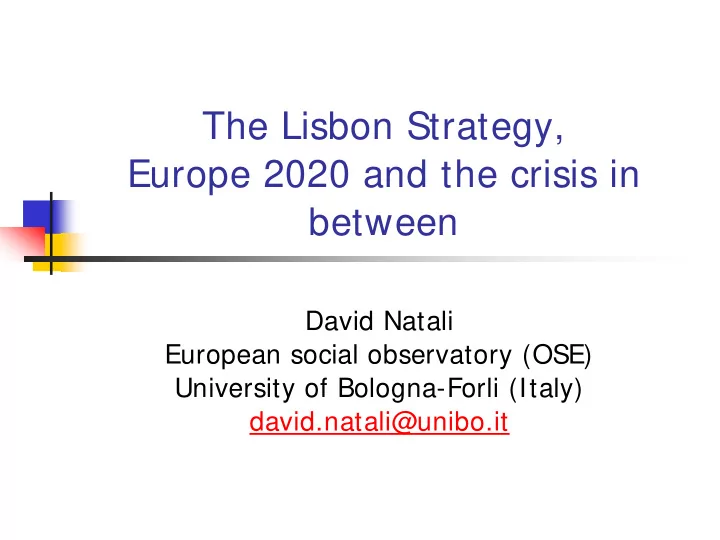

The Lisbon Strategy, Europe 2020 and the crisis in between David Natali European social observatory (OSE) University of Bologna-Forli (Italy) david.natali@unibo.it
Lisbon Strategy: promises, effects and the present debate E. Marlier and D. Natali (2010), ‘Europe 2020: Towards a more social EU?’, Brussels, PIE-Peter Lang.
Lisbon Strategy: promises, effects and the present debate � Promises (potential for Europeanization) � Effects (actual Europeanization) and the crisis � Present debate - Europe 2020
1. Promises (potential Europeanization)
1. Promises Lisbon Strategy, 2000 To transform the European economy a. of the 21st century and relaunch the EU To increase participation in EU b. governance To improve learning c.
a. Transforming the European economy (European malaise) � Problems � Low productivity and innovation � Economc rigidities, monopolies and oligopolies, high social spending � High unemployment � Remedies � Structural reforms (completion of the Internal Market) � Budgetary stability � Recalibrating welfare states
Why more EU integration? � Economic and social interdependence � Potential for learning � Improving EU citizens’ living conditions � Multilateralism and more legitimacy for the EU � Resurgence of social policy in the EU agenda
b. A new participatory mode of governance � New EU-toolkit (regulation, social dialogue, structural funds, soft governance) � OMC (Open method of coordination) � Experimental governance based on (joint diagnosis; common guidelines/indicators; assessment of national practices; periodic reports and evaluation); � Non binding knowledge creation, flexibility, decentralised policymaking, deliberation
c. A new Knowledge-based governance (learning) � Intensive consultation � Mutual learning � Benchmarking, indicators, exchange of best practices, peer review, reporting � Common knowledge production � Ideational dimension of policy change
2. Effects (actual Europeanization) and the crisis
2. Assessing the Strategy � not a single target has been achieved – and would not have been achieved in 2010 even without the crisis (Tilford and Whyte, 2009) – (e.g. employment rates, R&D, growth) � This raises the question of the underlying rationale and value of the indicators
Employment rates, Target 70%
Research and Development Investments, Target 3% GDP
Early school leavers: target 10%
The Crisis: first step – stock exchange trends
The Crisis: second step – economic recession
The Crisis: third step – budgetary tensions (deficit levels)
Governance � Unbalanced process (especially after 2005) � Limited participation � Low visibility � Limited political commitment � Limited evidence of policy diffusion
A more complex understanding...
a. Wrong policy agenda? � Is it necessary to coordinate all EU economies in line with a single model? (Amable 2009) � EU integration and national social models (coordination or clash?) (Ferrera 2005; Majone 2005) � Stability/Reform dilemma (Mabbett and Schelkle 2007)
b. The myth of participation � Mixed results (uneven participation) (de la Porte and Pochet 2005; Zeitlin 2010) � Access is poorly regulated (Kroger 2008) � More top-down approach (key role of committees) – technocratic process? (Smismans 2008)
c. Any evidence of learning? � New concepts/issues in national debates: activation, flexicurity, social investment, child poverty (de la Porte 2009) � Key role of technical committees (leverage for cognitive and normative convergence – obj.; indicators) (Jacobssonn 2005; de la Porte et al 2009) � Salience of some policy measures (training, make work pay, etc.) (Zeitlin 2008) � Improved institutional capabilities (Ferrera and Sacchi 2005)
7 Critical questions for Europe 2020
Europe 2020 � 3 priorities (smart, sustainable and inclusive growth) � 10 guidelines (6 economic, 4 on employment and social policy) � 5 targets (one on educational attainment, one on poverty) � 7 flagships (two on education and higher education in the ‘smart’ side of the strategy, one on poverty)
7 critical questions for the launch of Europe 2020 Wrong approach to further EU integration? 1. � No more integration ‘by stealth’ � No alternative to soft governance (in social and employment policy) Wrong policy agenda? 2. � Budgetary Stability and Structural Reforms What role for social and employment policy? 3. � More enphasis on poverty (part of the targets, one flagship and the 10th guideline)
7 critical questions for the launch of Europe 2020 Weak economic and social policy governance? 4. More thematic approach (3 priorities, 5 targets, 7 � flagships) A streamlined process (SGP driven?) � What room for participation 5. Limited participation/involvement of civil society and � parliaments More clear leadership �
7 critical questions for the launch of Europe 2020 Wath room for learning? 6. Due to excessive semplification (EPAP and OMC) � Key role of indicators, targets and impact assessment � What influence on national reforms? 7. More integrated approach (EU toolkit), structural funds �
Recommend
More recommend